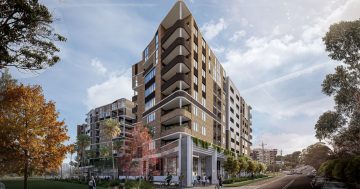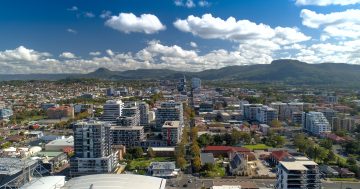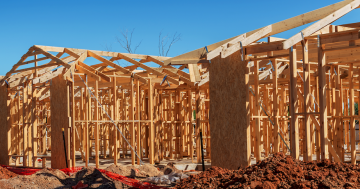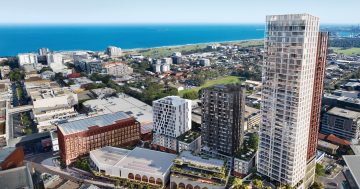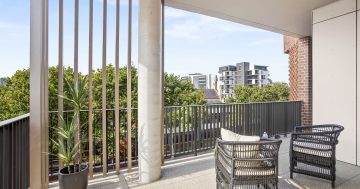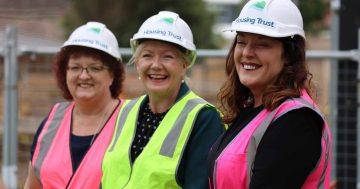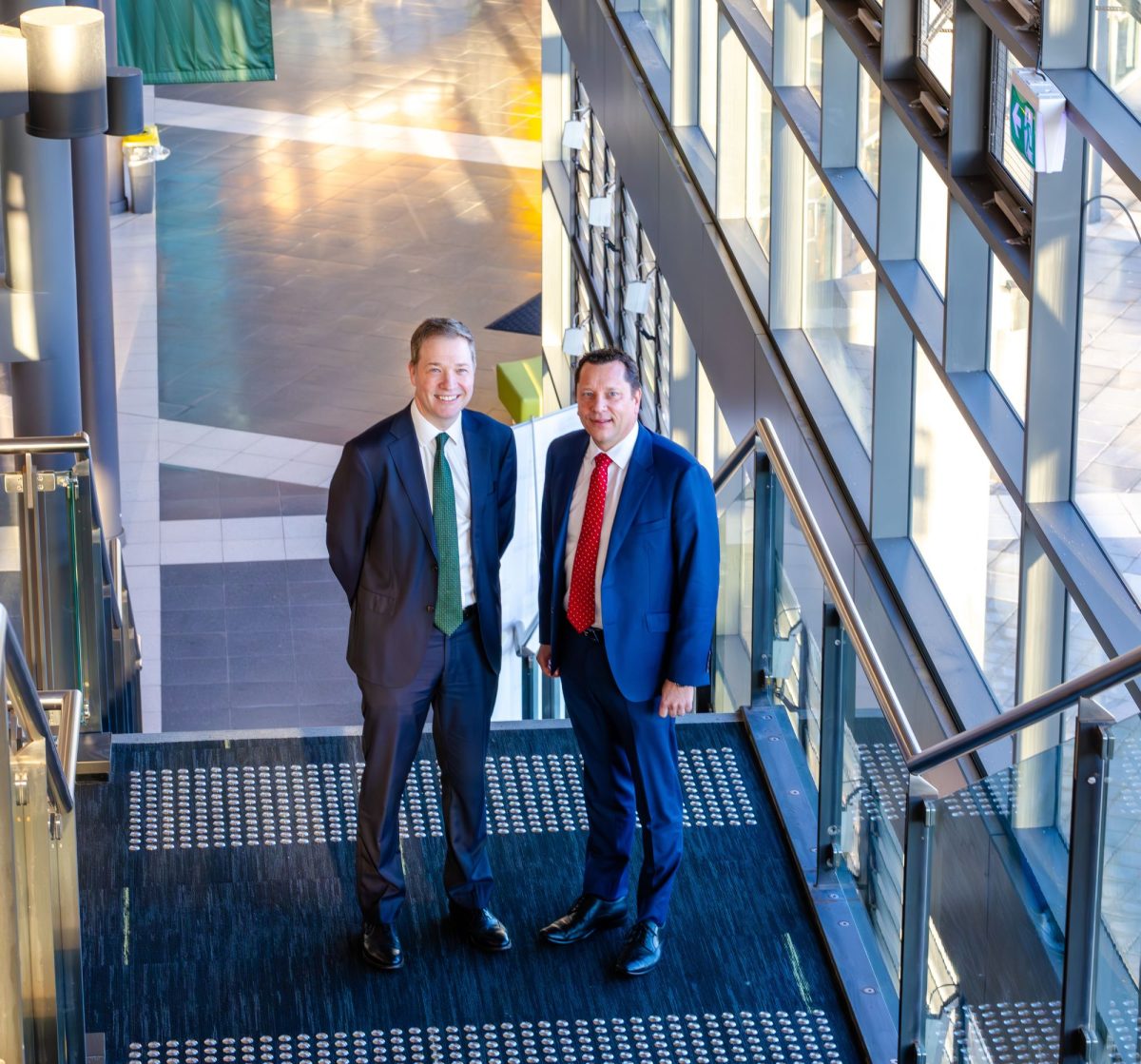
Business Illawarra Executive Director Adam Zarth with NSW Planning Minister Paul Scully at the launch of the Illawarra housing report. Photos: Business Illawarra
Narelle Clay is blunt: the housing crisis facing low income workers in the Illawarra is horrendous.
The Southern Youth and Family Services Chief Executive Officer has been working with vulnerable youth and families for decades and has never seen the housing situation in such a critical state.
Her organisation recently opened 20 units for vulnerable young people in Warilla – “a small drop in the ocean – I could fill 200 more immediately”.
One client, a 24-year-old woman in a wheelchair, has been searching for a home to rent for six years. She recently did a search for accessible accommodation at $1000 a week – way beyond what she could afford but just to see what was available – and came up empty. “There was not one – not one for $1000 a week.”
Narelle was a panel member at the launch of a new report commissioned by Business Illawarra into the affordable housing crisis across the Illawarra and Shoalhaven.
The report, prepared by Bulli planning experts Judith Stubbs & Associates, backs Narelle’s frank assessment of the housing crisis.
“Emergency short term crisis accommodation is full so people can’t get out because there is nowhere to go to,” Narelle said.
“Even when they’re starting to work, even when they’re able to have an income and would usually be able to go into the private market they can’t, so they’re stuck.
“That means homeless people are building up and they’re not getting anywhere. So they’re sleeping rough. There’s an increase in that.
“And we are finding massive blocks and the blocks are increasing. We’ve got people that I work with, vulnerable people and families, but now you’ve got key workers who can’t afford it – it’s a horrendous problem.”
The report, Solutions to the Affordable Housing Crisis in the Illawarra Shoalhaven, paints a bleak picture for workers earning the lowest incomes – critical workers in industries including residential aged care, retail, health and welfare, clerical and administration, construction and child care.
A child care worker earning a typical industry wage cannot afford to rent a one-bedroom home anywhere in the Illawarra or Shoalhaven. A family on a low income is unable to afford rental properties in most parts of the region.
More than 22,000 Illawarra households are living in housing stress, where they spend more than 30 per cent of their income on accommodation. The report predicts that about 11,645 additional dwellings could be needed to meet demand by 2041, and 3925 of those would need to be social housing.
A gathering of politicians, business and community leaders and housing providers at the launch of the report was told there was no one solution to the current housing crisis and that it would take a combined effort by all three tiers of government to fix.
A raft of recommendations also calls for action from community housing providers, property developers, large employers and Business Illawarra itself.
Business Illawarra Executive Director Adam Zarth said businesses across the region were facing a critical shortage of key workers who, in turn, could not find affordable accommodation locally.
According to the report, 93 per cent of businesses are concerned about increasing workforce shortages across key sectors of the economy and 43 per cent point to lack of affordable housing as the cause.
It defines a key worker as a public or private sector worker fulfilling a critical function, earning between $756 and $1813 per week.
“The housing affordability situation across all areas of the region is dire,” the report said.

Southern Youth and Family Services Chief Executive Officer Narelle Clay during the panel discussion.
“Median rent on a one-bedroom unit was not affordable for any very low income renters in any of the LGAs. Although the situation is somewhat better for smaller moderate income households, those needing housing suitable for families would not be able to rent affordable housing in most parts of the region.”
The report outlines how the region has been impacted by the displacement of Sydney residents who can’t afford housing in the city.
“Migration data from 2016-17 shows a trend to displacement of people from north to south in the region as the increasing cost of housing in Sydney flows through to the region,” the report said.
“Overall, migration trends show the effects of the Sydney housing market rolling down the coast, progressively displacing people on lower incomes.”
However, migration is only one contributing factor to the crisis. The report also lists loss of social housing, steep increases in rent (10.7 per cent in Shellharbour and 7.2 per cent in Shoalhaven over the past two years), wages not keeping pace with housing prices, increased and ongoing delays in the planning system to approve building applications, legislation and tax impacts and demographic change, including our ageing population
At the report launch, NSW Planning Minister and Wollongong MP Paul Scully said the size of the crisis was now so large that no one housing type or tenure would fix it.
“Similarly, the problem won’t be solved by either the private sector or the public sector alone, it needs both. One level of government alone can’t solve the problem, it’s going to take all three levels of government using the levers that they have available to address the issue,” he said.
Mr Scully said the NSW Government had introduced new measures to encourage affordable housing growth, including new planning pathways for residential development valued at more than $75 million, self-assessment for some social and affordable developments, and reducing the minimum lot size for dual occupancies for certain organisations.
In the Illawarra, the Rezoning Pathways pilot program has identified the Warrawong Plaza site, which proposes more than 1100 new homes including an affordable housing component.
“The government understands the pressures in the housing system and we’re taking action to address that. We will continue to implement reforms and help to address supply problems by encouraging greater density in well located, well-designed and well-built communities because that’s where we can get the best bang for our buck in terms of the cost of infrastructure needed to support housing growth,” Mr Scully said.
“Today’s report has been described as a warning shot across the bows of government and it is, but it’s also a warning shot across the bows that existing residents must also be prepared to welcome new people into their community.”
Business Illawarra has committed to developing a community education campaign about the need for affordable housing to increase awareness and reduce community opposition. It will continue to advocate for the key initiatives highlighted in the report with each level of government.
Some of the recommendations:
Federal Government
- Provide funding certainty for the region under the $10 billion Housing Australia Future Fund investment intended to provide for 30,000 new dwellings across Australia including 20,000 social housing and 10,000 affordable housing dwellings for ‘frontline workers’
State Government
- To support existing commitments including a $30 million pilot build-to-rent program on the South Coast that will be delivered by Landcom; and a directive from the Premier that Ministers identify vacant government-owned land within their portfolios to be rezoned for housing – and a mandate for 30 per cent social, affordable and universal housing on government-owned land
- Reduce the processing times for development applications that are holding back new housing supply, including addressing the critical shortfall of planners that is causing delays in the planning approvals process
- Establish streamlined planning processes that create clear delineations between state and council responsibilities
- Standardise housing design to expedite planning approvals
- Ensure key worker housing is provided as part of all state government-led major employment generating projects, eg, the new Shellharbour Hospital and the redeveloped Shoalhaven Hospital.
Councils
- Allow higher densities in town CBDs across the region, including Dapto, Warrawong, Oak Flats, Corrimal, Nowra/Bomaderry, Ulladulla and Kiama
- Expedite approvals and reduce or waive fees for genuinely affordable housing proposals
- Reduce minimum lot sizes around planned town centres in greenfield developments to facilitate the delivery of small lot housing, including row housing.
You can read the report on the Business Illawarra website.









